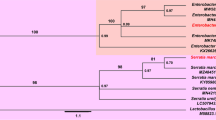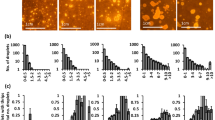Abstract
In the present study, experiments were carried out in French bean fields over two planting periods to evaluate the potential use of sticky traps for monitoring the populations of pest thrips. To this end, blue, yellow and clear sticky traps (with and without a thrips lure, i.e. Lurem-TR) were tested. Field observations on thrips catches were made at weekly intervals from the sticky traps, and absolute estimates of thrips populations and their natural enemies were made by destructive (picking leaves and flowers) and non-destructive sampling (plant tapping) of plants until crop senescence during the two planting periods. Blue traps caught two and three times more thrips compared with yellow traps over the first and second planting periods, respectively. Blue traps were more attractive to Megalurothrips sjostedti (Trybom), Frankliniella schultzei (Trybom) and Frankliniella occidentalis (Pergande), while yellow traps were only attractive to Hydatothrips adolfifriderici (Karny) and the natural enemies of thrips. The addition of Lurem-TR to the sticky traps significantly increased the capture of all thrips species, but not their natural enemies. The estimates of thrips populations from blue sticky traps with Lurem-TR were found to be highly correlated (r = 0.95; P 0.001) with the absolute estimates of thrips using the destructive sampling method. The results demonstrate that blue sticky traps and Lurem-TR can be an efficient tool for the monitoring of thrips populations on French beans with least influence on their natural enemies.
Similar content being viewed by others
References
Affandi B. and Emilda D. (2009) Mangosteen thrips: collection, identification and control. Journal of Fruit and Ornamental and Plant Research 17, 219–233.
Allsopp E. (2010) Investigation into the apparent failure of chemical control for management of western flower thrips, Frankliniella occidentalis (Pergande), on plums in the Western Cape Province of South Africa. Crop Protection 29, 824–831.
Bout A., Boll R., Mailleret L. and Poncet C. (2010) Realistic global scouting for pests and diseases on cut rose crops. Journal of Economic Entomology 103, 2242–2248.
Broughton S. and Harrison J. (2012) Evaluation of monitoring methods for thrips and the effect of trap colour and semiochemicals on sticky trap capture of thrips (Thysanoptera) and beneficial insects (Syrphidae, Hemerobiidae) in deciduous fruit trees in Western Australia. Crop Protection 42, 156–163.
Brunner P. C. and Frey J. E. (2010) Habitat-specific population structure in native western flower thrips Frankliniella occidentalis (Insecta, Thysanoptera). Journal of Evolutionary Biology 23, 797–804.
Chen T. Y., Chu C. C., Fitzgerald G., Natwick E. T. and Henneberry T. J. (2004) Trap evaluations for thrips (Thysanoptera: Thripidae) and hoverflies (Diptera: Syrphidae). Environmental Entomology 33, 1416–1420.
Chu C. C., Ciomperlik M. A., Chang N. T., Richards M. and Henneberry T. J. (2006) Developing and evaluating traps for monitoring Scirtothrips dorsalis (Thysanoptera: Thripidae). Florida Entomologist 89, 47–55.
Cloyd R. A. and Sadof C. S. (2003) Seasonal abundance and the use of an action threshold for western flower thrips, Frankliniella occidentalis (Pergande), in a cut carnation, Dianthus caryophyllus L. greenhouse. HortTechnology 13, 497–500.
Davidson M. M., Butler R. C. and Teulon D. A. J. (2009) Pyridine compounds increase thrips (Thysanoptera: Thripidae) trap capture in an onion crop. Journal of Economic Entomology 102, 1468–1471.
Davidson M. M., Perry N. B., Larsen L., Green V. C., Butler R. C. and Teulon D. A. J. (2007) 4-Pyridyl carbonyl compounds as thrips lures: effectiveness for Western flower thrips in y-tube bioassays. Journal of Agriculture Food and Chemistry 56, 6554–6561.
Desneux N., Decourtye A. and Delpuech J. M. (2007) The sublethal effects of pesticides on beneficial arthropods. Annual Reviews of Entomology 52, 81–106.
Fox J. (2005) The R commander: a basic-statistics graphical user interface to R. Journal of Statistical Software 14, 1–42.
Hamilton J. G. and Kirk W. D. J. (2003) Method of monitoring/controlling Thysanoptera. Patent WO 2003/055309.
Hamilton J. G., Hall D. R. and Kirk W. D. J. (2005) Identification of a male-produced aggregation pheromone in the western flower thrips Frankliniella occidentalis. Journal of Chemical Ecology 31, 1369–1379.
Harbi A., Elimem M. and Chermiti B. (2013) Use of a synthetic kairomone to control Frankliniella occidentalis Pergande (Thysanoptera; Thripidae) in protected pepper crops in Tunisia. The African Journal of Plant Science and Biotechnology 7, 42–47.
HCDA (Horticultural Crops Development Authority) (2010) Export statistics volumes. Available at: https://doi.org/www.hcda.or.ke/Statistics/2010ai]20Horticultureai]20 Validatedai]20Report.pdf/ (accessed 20 March 2014).
Hernandez L. M. and Stonedahl G. M. (1999) A review of the economically important species of the genus Orius (Heteroptera: Anthocoridae) in East Africa. Journal of Natural History 33, 543–568.
Hoddle M. S., Robinson L. and Morgan D. (2002) Attraction of thrips (Thysanoptera: Thripidae and Aeolothripidae) to colored sticky cards in a California avocado orchard. Crop Protection 21, 383–388.
Jaetzold R. and Schmidt H. (1983) Farm Management Handbook of Kenya Vol. II, Natural Conditions and Farm Management Information. Part B: Central Kenya (Rift Valley and Central Provinces). Ministry of Agriculture, Kenya, in cooperation with the German Agricultural Team (GAT) of the German Agency for Technical Cooperation (GTZ).
Jaetzold R., Schmidt H., Hornetz B. and Shisanya C. (2007) Farm Management Handbook of Kenya, rev. edn. Ministry of Agriculture, Kenya.
Joost H. and Riley D. G. (2004) Sampling techniques for thrips (Thysanoptera: Thripidae) in preflowering tomato. Journal of Economic Entomology 97, 1450–1454.
Koschier E. H. (2006) Plant allelochemicals in thrips control strategies, pp. 221–249. In Naturally Occurring Bioactive Compounds Vol. 3, Advances in Phytomedicine (edited by M. Rai and M. C. Carpinella). Elsevier Science, Amsterdam.
Liu T. X. and Chu C. C. (2004) Comparison of absolute estimates of Thrips tabaci (Thysanoptera: Thripidae) with field visual counting and sticky traps in onion field in south Texas. Southwestern Entomologist 29, 83–89.
Macintyre-Allen J. K., Scott-Dupree C. D., Tolman J. H. and Harris C. R. (2005) Evaluation of sampling methodology for determining the population dynamics of onion thrips (Thysanoptera: Thripidae) in Ontario onion fields. Journal of Economic Entomology 98, 2272–2281.
Moritz G., Brandt S., Triapitsyn S. and Subramanian S. (2013) Pest Thrips in East Africa: Identification and Information Tools. QAAFI Biological Information Technology (QBIT), The University of Queensland, Brisbane. ISBN 978-1-74272-067-8.
Moritz G., Mound L. A., Morris D. C. and Goldarazena A. A. (2004) Pest thrips of the world - visual and molecular identification of pest thrips. Cd-rom published by OBIT, Brisbane. Available at: https://doi.org/wwwcbit.uq.edu.au/software/pestthrips/default.htm
Natwick E. T., Byers J. A., Chu C. C., Lopez M. and Henneberry T. J. (2007) Early detection and mass trapping of Frankliniella occidentalis and Thrips tabaci in vegetable crops. Southwestern Entomologist 32, 229–238.
Nderitu J. H., Kasina M. J., Nyamasyo G. N., Waturu C. N. and Aura J. (2008) Management of thrips (Thysanoptera: Thripidae) on French beans (Fabaceae) in Kenya: economics of insecticide applications. Journal of Entomology 5, 148–155.
Nderitu J. H., Waturu C. N., Olubayo F., Aura J. and Kasina J. (2001) Current French bean pests and disease management at Mwea Tebere, Central Kenya, pp. 118–122. In Proceedings of the Horticulture Seminar on Sustainable Horticultural Production in the Tropics (Edited by J. M. Wesonga, T. Losenge, C. K. Ndung’u, K. Ngamau, F. K. Ombwara, S. G. Agong, A. Fricke, B. Hau and H. Stützel). Department of Horticulture, Jomo Kenyatta University of Agriculture and Technology (JKUAT), Institute of Vegetable and Fruit Science and Institute of Plant Diseases & Plant Protection, University of Hannover, and German Academic Exchange Service (DAAD).
Nielsen M.-C., Worner S., Chapman B., de Kogel W.-J., Perry N., Sansom C., Murai T., Muvea A. M., Subramanian S., Davidson M. and Teulon D. (2010) Optimising the use of allelochemicals for thrips pest management, p. 324. In Book of Abstracts of the 26th Annual Meeting of the International Society of Chemical Ecology, 31 July–4 August 2010, Tours, France.
Nyasani J. O., Meyhöfer R., Subramanian S. and Poehling H.-M. (2012) Effect of intercrops on thrips species composition and population abundance on French beans in Kenya. Entomologia Experimentalis et Applicata 142, 236–246.
Parajulee M. N., Shrestha R. B. and Leser J. F. (2006) Sampling methods, dispersion patterns, and fixed precision sequential sampling plans for western flower thrips and cotton flea hoppers (Miridae) in cotton. Journal of Economic Entomology 99, 568–577.
Pearsall I. A. and Myers J. H. (2000) Population dynamics of western flower thrips (Thysanoptera: Thripidae) in nectarine orchards in British Columbia. Journal of Economic Entomology 93, 264–275.
Pizzol J., Nammour D., Hervouet P., Bout A., Desneux N. and Mailleret L. (2010) Comparison of two methods of monitoring thrips populations in a greenhouse rose crop. Journal of Pest Science 83, 191–196.
R Development Core Team (2011) R: A Language and Environment for Statistical Computing. pp. 18–25. Available at: https://doi.org/www.r-project.org/ (accessed 20 April 2014).
Rodriguez-Saona C. R., Byers J. A. and Schiffhauer D. (2012) Effect of trap color and height on captures of blunt-nosed and sharp-nosed leafhoppers (Hemiptera: Cicadellidae) and non-target arthropods in cranberry bogs. Crop Protection 40, 132–144.
Seif A. A., Varela A. M., Michalik S. and Lohr B. (2001) A Guide to IPM in French Beans Production with Emphasis on Kenya. ICIPE Science Press, Nairobi, Kenya. 72 pp. ISBN 92 9064 142 8.
Steiner M. Y. (1990) Determining population characteristics and sampling procedures for F. occidentalis (Thysanoptera: Thripidae) and the predatory mite (Acari: Phytoseiidae) on greenhouse cucumber. Environmental Entomology 19, 1603–1605.
Terry L. I. (1997) Host selection, communication and reproductive behavior, pp. 435–475. In Thrips as Crop Pests (edited by T. Lewis). CAB International, Wallingford, UK.
Teulon D. A. J., Penman D. R. and Ramakers P. M. J. (1993) Volatile chemicals for thrips (Thysanoptera: Thripidae) host finding and application for thrips pest management. Journal of Economic Entomology 86, 1405–1415.
Teulon D. A. J., Davidson M. M., Hedderley D., James D. E., Fletcher C. D., Larsen L., Green V. C. and Perry N. B. (2007) 4-Pyridyl carbonyl and related compounds as thrips lures: effectiveness for onion thrips and New Zealand flower thrips in field experiments. Journal of Agricultural and Food Chemistry 55, 6198–6205.
Triapitsyn S. V. (2005) Revision of Ceranisus and the related thrips-attacking entedonine genera (Hymenoptera: Eulophidae: Entedoninae) of the world. African Invertebrates 46, 261–315.
Waite M. O. (2012) New strategies to improve the efficiency of the biological control agent, Orius insidiosus (Say), in greenhouse ornamental crops. MSc thesis, The University of Guelph, 145 pp. Available at: https://doi.org/atrium.lib.uoguelph.ca/ (accessed 30 June 2014).
Yaku A. G., Walter G. H. and Najar-Rodrigueza A. J. (2007) Thrips see red - flower colour and the host relationships of a polyphagous anthophilic thrips. Ecological Entomology 32, 527–535.
Author information
Authors and Affiliations
Corresponding author
Rights and permissions
About this article
Cite this article
Muvea, A.M., Waiganjo, M.M., Kutima, H.L. et al. Attraction of pest thrips (Thysanoptera: Thripidae) infesting French beans to coloured sticky traps with Lurem-TR and its utility for monitoring thrips populations. Int J Trop Insect Sci 34, 197–206 (2014). https://doi.org/10.1017/S174275841400040X
Received:
Published:
Issue Date:
DOI: https://doi.org/10.1017/S174275841400040X




